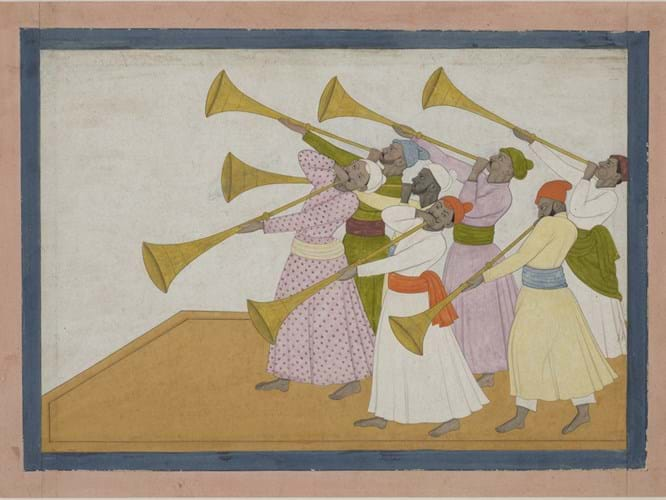The picture was temporarily prevented from being exported by the Department for Digital, Culture, Media and Sport in 2018 when its owner applied for an export licence.
A search was begun for a buyer to match the £550,000 asking price.
The Trumpeters by Nainsukh of Guler has been described as a work “unparalleled in north Indian art”.
Thought to have been created between 1735-40, it depicts a traditional musical performance in northern India with seven musicians playing Pahari horns with long pipes known as turhi.
The painting has been in a private collection since being purchased by the prominent British artist Winifred Nicholson (1893-1981) during a tour of India, Burma (Myanmar) and Ceylon (Sri Lanka) in 1919-20. After Nicholson’s death, it remained with her family and this is now the first time it has entered a public collection.
‘Stunning’
The museum was able to raise the funds to buy it with help from the Art Fund, the National Heritage Memorial Fund (NHMF) and the Brooke Sewell Permanent Fund.
Sir Peter Luff, chair of the NHMF, said: “This miniature watercolour is a stunning example of Pahari art. The Trustees of the National Heritage Memorial Fund agreed it was imperative to save The Trumpeters for the nation.”
Nainsukh is regarded as the most famous artists using the Pahari or ‘Hill’ style of painting, which developed in the Punjab Hills of north-west India.
Three other paintings by Nainsukh are already in the collection of the British Museum, having been donated in the 1940s. Together these paintings can be seen and studied alongside the museum’s extensive south Asia collections, allowing for further understanding of the full scope of the Pahari painting tradition.
‘Delight of the Eyes’
This painting is now on display in the museum’s Sir Joseph Hotung Gallery of China and south Asia.
Imma Ramos, curator at the British Museum, said: “Nainsukh, whose name translates as ‘Delight of the Eyes’, is one of India’s greatest courtly artists, and this outstanding painting showcases his gift for complex composition and precise observation.
“It was painted at the height of his career while he was working for the ruler of Jasrota, Raja Balwant Singh. Its jewel-like colour, intricate detail and poetic mood suggest it would have been seen up close and studied at leisure, enjoyed privately or among guests.”






